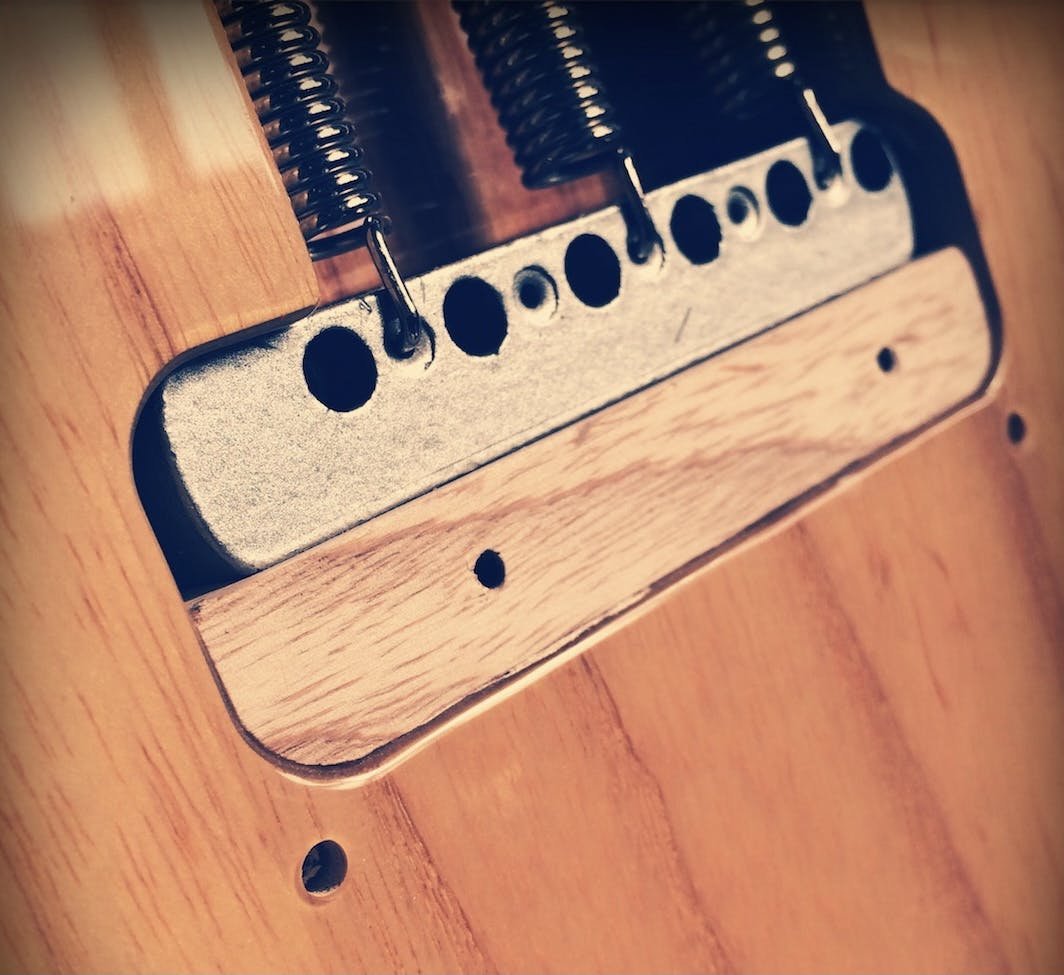Blocking a Tremolo Bridge
Not everyone uses—or even likes—a tremolo bridge. You can love a Strat but hate that bloody wobbly bridge. Eric Clapton is famous for disliking, among other things, wobbly bridges on his Strat. So he has them blocked.
What’s involved in stopping the wobble?
Well, on some guitars, you can just jam in some more springs and tighten the tremolo claw way up. That pulls really hard on the bridge and forces it back hard against the guitar top. The added pull of the extra springs, tightened way up, means the bridge will stay put under string-tension and won’t lose tune if you break a string.
How to block a Strat-style vibrato bridge
We can go a step further, though. We can install a piece of wood in the routed tremolo cavity—between rear cavity wall and the sustain-block (that hefty hunk of metal around the back of your tremolo bridge with the springs attached). The wood wedges the bridge into place, preventing it moving. Doing this is a very effective method of hard-tailing the bridge and many players feel it enhances the instrument's sustain (but you should do your own carefully controlled, double-blinded experiments to confirm this). Adding the block is a more sure method and I prefer it.
Regarding the choice of wood, being a nerd, I like to use a piece of ash or alder (as appropriate to the guitar). Of course, I’m in the fortunate position of having some pieces of ash or alder around. Any hard-enough wood will do the trick really.
It’s not a particularly complicated job to fit the block but it will likely involve a little back-and-forth to get the best fit. Measure between the rear of the sustain-block and the rear of the cavity. I’d advise you do this at both ends of the block as the measurement may well be slightly different.
Now you have this measurement, it’s worth trying to determine whether it’s the same all the way down. Many sustain-blocks are tapered and increase in width as the get closer to the bridge base. That means the gap between trem-block and cavity wall reduces as you get lower down. Of course, it’s tricky to measure down this deep. Another piece of wood (of known dimensions) and some stacked feeler gauges will work if you don’t fancy trial-and-erroring this. Get your top and bottom measurement and you’re good to go.
Cut the wood block to rough size. For length, the longer the better but at least as long as the sustain-block if you can. Even better if you can span the width of the cavity. I like to shape the back corners of the block to fit into the rounded corners of the cavity. Do this first and you can then trim the other (trem-facing) side to final thickness.
It’s best to creep up on that final thickness. Keep fitting the block and you’ll get a feel for how well it’s inserting. You’re looking for a pretty tight fit here.
How tight? Well, let me mention that Dan Erlewine has a great tip of drilling a hole in the outer face of the wood block. The hole allows you to thread in a screw to help pull out the block should you need. So, yeah… that tight.
Depth will vary. It depends on the guitar and trem to an extent. I will sometimes aim to fill any gap and make the block pretty flush with the back surface of the guitar but I try to, at least, keep the wood block reasonably close to the depth of the sustain block. It’s not always possible as things can get in the way but do what you can.
When you’ve a solid, wedge fit, with (hopefully) no gaps at the contact surfaces, you’re good. Check the springs aren’t loose—I usually tighten them right down. Strictly speaking, you could remove the springs at this point if you really wanted. That said, many people (me included) feel that the springs form a part of the tone equation, even when blocked like this. And, of course, if you remove the springs, you would break the connection between the bridge and the string–ground wire on the trem-claw. That would make it necessary to ground the bridge in some other method. Who needs the hassle—just leave the springs.
Next week, we’ll look at dealing with an annoying wrinkle when it comes to blocking some instruments. For now, that’s your lot.
This article written by Gerry Hayes and first published at hazeguitars.com












